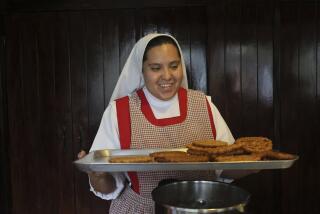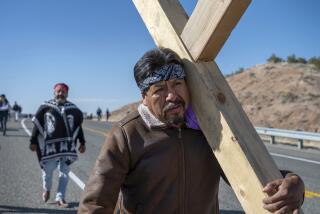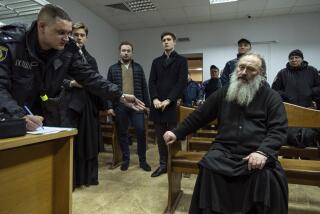Airstrip, Road End Monks’ Isolation : Tourists Peril the Serenity of Ancient Sinai Monastery
- Share via
ST. CATHERINE'S MONASTERY, Egypt — At the peak of one of the highest mountains in the biblical land of the Sinai, overlooking this 1,450-year-old monastery, a Greek Orthodox monk has lived in solitude for 20 years in a cave.
The only evidence that he is there, praying and meditating in the quiet beauty of the desert peninsula, is a white cross on the mountaintop. His 17 Christian brothers at St. Catherine’s Monastery never see him except when he descends the steep granite slope every few months for supplies.
He is the only one of them not disturbed by tourists who have been coming here by the thousands since the Israelis built an airstrip nearby and the Egyptians built a road to the monastery’s door.
When the monk first went up to live in his cave, the nearest paved road ran along the Red Sea coast, about 60 miles away.
War of 1967
Israel built the airstrip after its forces seized the Sinai in the 1967 Arab-Israeli war. Egypt paved the road after the Israelis withdrew.
Now St. Catherine’s is a tourist site.
Tens of thousands from around the world come every year to roam through the monastery’s 6th-Century chapel and its surrounding compound.
Tourists are attracted by a handful of historic monasteries and convents scattered among the craggy mountains and deep valleys close to Mt. Sinai, where the Bible says God gave Moses the 10 Commandments.
Beginning in the 3rd Century, Christian monks and nuns fled religious persecution and came to the Sinai.
St. Catherine’s Monastery was built in 532 by the Byzantine Emperor Justinian. To keep out marauding nomads, the monastery could be entered only by a basket lowered down its wall.
Today, visits employ a more conventional entrance--a door beside the paved parking lot. During religious seasons, as many as 1,000 tourists throng to St. Catherine’s in a day.
Greek Stipend
The monks put up with the interruption for a worldly reason--money. Other than tourism, the monastery’s only income comes from an annual stipend from the Culture Ministry of Greece, contributions from pilgrims and revenue from its 150-bed guest hostel.
Nevertheless, the brothers don’t like it.
“If I wanted this, I would go to the Hilton and be a receptionist,” one monk said. Like others interviewed, he would talk to a reporter only on condition that his name not be used.
Tourists are allowed to walk through the narrow winding paths of the monastery and compound. Inside the chapel, built in 1934 with stones of the original church, a marble sarcophagus holds the remains of St. Catherine.
The monastery library, which the monks say is second in importance only to that of the Vatican among collections of its kind, includes 3,000 items in Greek, Arabic, Syriac, Georgian, Armenian, Coptic, Ethiopian and Slavonic. Like the icons and mosaics, the library manuscripts have been collected from all over the world.
“We are 17, but we need 17 for the library duties alone,” another monk said. “Nobody wants to come here (as a monk). It’s hard to live in the desert.”
Execution Order
St. Catherine lived in the early 4th Century in the ancient Egyptian port of Alexandria, then under control of the Romans.
According the the monastery’s guidebook, Emperor Maximinius ordered her executed because she converted to Christianity. The method of execution was to be by wheel with sharp-edged iron spikes. But the guidebook, published by the Egyptian Information Service, adds that “she was snatched by an invisible hand before the wheel killed her, and her torturers were killed in her place.”
The book says she finally was beheaded.
Legend has it that her body vanished after the execution but that three centuries later, monks of the monastery, guided by a dream, found her remains on the highest mountain in the Sinai, now named after her.
The monastery was dedicated in her name in the 11th Century.
Also in the 11th Century, the monks built a mosque inside the monastery grounds to placate Arab rulers, despite a document from the Muslim Prophet Mohammed that pledged protection for the monastery.
The document is on display today in the chapel.
Orthodox Convent
Not far from the monastery is a Greek Orthodox convent with a chapel built from the stones of a monastery that local Bedouin Arabs claim is even more ancient than St. Catherine’s.
Only seven nuns live in the convent at one time, shying away from tourists but allowing them to walk around the gardens filled with olive and hazelnut trees.
Besides the monks and nuns, the rest of the southern Sinai is sparsely populated by Bedouin Arabs, who raise livestock and limited crops irrigated by scarce winter rains.
Many of the Bedouin families, most of whom are Muslims, have worked in the monasteries for generations. They can be seen regularly on monastery grounds kneeling in prayer facing in the direction of Mecca, the Islamic shrine in Saudi Arabia.
“We don’t proselytize,” said one monk in reference to the Bedouins. “We respect all religions, and we live peacefully.”
More to Read
Sign up for The Wild
We’ll help you find the best places to hike, bike and run, as well as the perfect silent spots for meditation and yoga.
You may occasionally receive promotional content from the Los Angeles Times.






